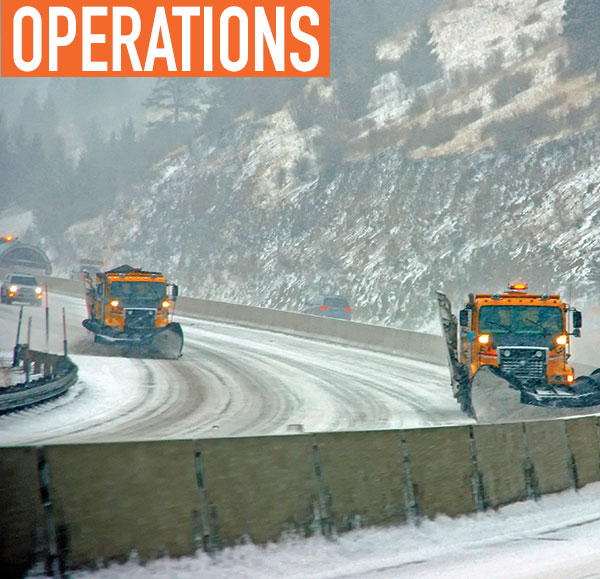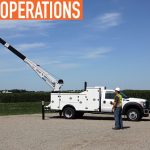Fleet managers in Massachusetts and Vermont upfit snowplow trucks with an automated electronic spreader control system that collects and records accurate data on the amount of salt and other deicing materials and liquids applied to winter road surfaces.
Around 25 years ago, the goal for a winter road maintenance fleet manager was straightforward—keep highways safe for travelers and don’t worry too much about the amount of salt applied to roadway surfaces. Fast forward to 2017. Fleet managers are now accountable for keeping roads safe for winter travelers, controlling costs, and being environmentally responsible by reducing the amount of salt applied to roadways and, in some states, complying with legislated mandates regarding the amount of salt to apply per lane mile.
To balance the multiple goals of today’s snow and ice control industry, fleet managers from the Massachusetts Department of Transportation (Mass DOT) and the city of South Burlington, Vermont, have installed an automated electronic spreader control system on their snowplow trucks. These agencies have also implemented a winter road maintenance system that generates reports and maps based on the data collected and recorded by the electronic spreader control system.
WINTER MAINTENANCE
A winter road maintenance system for snowplow trucks integrates vehicle sensors, an automated electronic spreader control system, and wireless data transfer to provide accurate data for building maps and reports that snow and ice control fleet managers need to improve operations and reduce costs.
GPS sensors collect and record data on a snowplow truck’s heading, speed, geographical location, and the date and time. Other sensors installed on a truck record data on ground speed, spreader operation, plow position, and air and road surface temperatures.
The automated electronic spreader control system provides calibrated spreading of salt and other deicing materials and liquids. Using the system’s sensors, the spreader controller detects the ground speed of the snowplow truck and adjusts the truck’s material delivery rate in proportion to its speed. Using spreader sensors, the closed-loop ground speed spreader controller automatically relates the speed of a truck and the calibrated speed of its salt/sand or liquid flow rate on the discharge end. The controller uses both data sources, and may also use air and surface temperatures, to control the spreader application rate.
The spreader controller collects and records data—every six seconds—on the amount and type of granular or liquid materials applied to winter roadway surfaces. The controller can be programmed to spread materials and liquids at a specific rate per lane mile.
A wireless data transfer system collects, compiles, and automatically downloads to a server the snowplow truck spreading application data at regularly timed intervals. Fleet managers can then access accurate “raw” data, as well as easy-to-use reports and maps on spreading activities, using any computer with Internet access.
Winter road maintenance systems are available from a handful of vendors, including Certified Cirus Control Systems (CCCS) located in Minneapolis, Minnesota.
MASS DOT
Mass DOT implemented its winter road maintenance system in September 2012. To date, Mass DOT has upfitted approximately 50 of its 125 state-owned snowplow trucks with an automated electronic spreader control system. Mass DOT snowplow trucks and private contractors are responsible for snow and ice removal on over 20,000 lane miles of highways. The state-owned trucks are responsible for winter road maintenance on the Massachusetts Turnpike. The toll road is the easternmost 138-mile stretch of Interstate 90 and runs from the New York border to downtown Boston.

FEATURED IMAGE: Winter road maintenance system and spreader application data can compare year to year productivity to help forecast budgets for the following year.
ABOVE: To balance the multiple goals of today’s snow and ice control industry, fleet managers have installed an automated electronic spreader control system on their snowplow trucks.
To comply with the state’s salt-spreading mandate and to be environmentally responsible, Mass DOT has been programming its snowplow truck spreaders to apply 240 lbs of pre-wetted salt (NaCl) per lane mile for the last 10 years. During much of this time, however, Mass DOT was not able to confirm how close it was to its goal application rate. “Now, with our winter road maintenance system and its use of ground speed control and wireless download, we’re able to verify that we’re in compliance and that’s what we’re talking about to the legislature and regulators,” says Paul Brown, snow and ice engineer for Mass DOT District 1. “We’re also letting them know that we’re being responsible. We’re using the right application on the right road at the right time and we’re getting very good results. You can’t do that unless you’re able to prove what the trucks are doing.”
Even though Mass DOT has saved close to 10,000 tons of salt per year since implementing its winter road maintenance system, “The real value of the system is that it makes a lot more people accountable for their actions, in the sense they’re doing what policy requires, and Mass DOT now has the data to back up their actions,” says Brown.
SOUTH BURLINGTON
To the northeast, the city of South Burlington, Vermont, uses its winter road maintenance system, and in particular, its detailed spreader application data to compare where it stands from year to year, help forecast its salt budget for the following year, and compile data on salt use costs. “When the city council asks us what our costs are, so they can make a judgment on how often they want snowplow truck operators to go out, we can tell them, ‘Every time we go out for an average storm, it’s $1,500 in salt for a four-hour run with three operators,’” says Adam Cate, South Burlington operation manager.
After each storm event, Todd Gregory, an engineering technician for South Burlington, collects the spreader data downloaded from each snowplow truck. “Basically, at the end of each shift, I put together a spreadsheet with gallons and lbs per driver, per truck, per storm. I can break the information down to an average cost per operator, per hour for a storm on regular time or overtime. I also think when truck operators have an opportunity to see the numbers, to see what they’re using, it makes a difference going forward, as to the way they think about putting salt and liquid down,” says Gregory.

Fleet managers are accountable for keeping roads safe for winter travelers, controlling costs, and being environmentally responsible by reducing the amount of salt applied to roadways.
Since installing its winter road maintenance system in 2010, South Burlington has cut its salt use by approximately 25 percent.
South Burlington is located a few miles from the eastern shore of Lake Champlain in northern Vermont. For each storm event, the city uses nine snowplow trucks to maintain about 255 lane miles of roads.
At the end of the day, the old operations adage, “You can’t manage what you don’t measure,” still rings true. But, thanks to data from an automated electronic spreader control system installed on snowplow trucks, and the reports and maps available in a winter road maintenance system, fleet managers can measure and manage their use of salt and other deicing materials and liquids applied to winter road surfaces to effectively achieve and balance their agency’s specific set of goals.
FOR MORE INFORMATION:
Find out more about Certified Cirus Control Systems products and services, call 763.493.9380, email info@certifiedcirus.com, or visit www.certifiedcirus.com.
_______________________________________________________________________
MODERN WORKTRUCK SOLUTIONS: MARCH 2017 ISSUE
Did you enjoy this article?
Subscribe to the FREE Digital Edition of Modern WorkTruck Solutions magazine.
![]()




